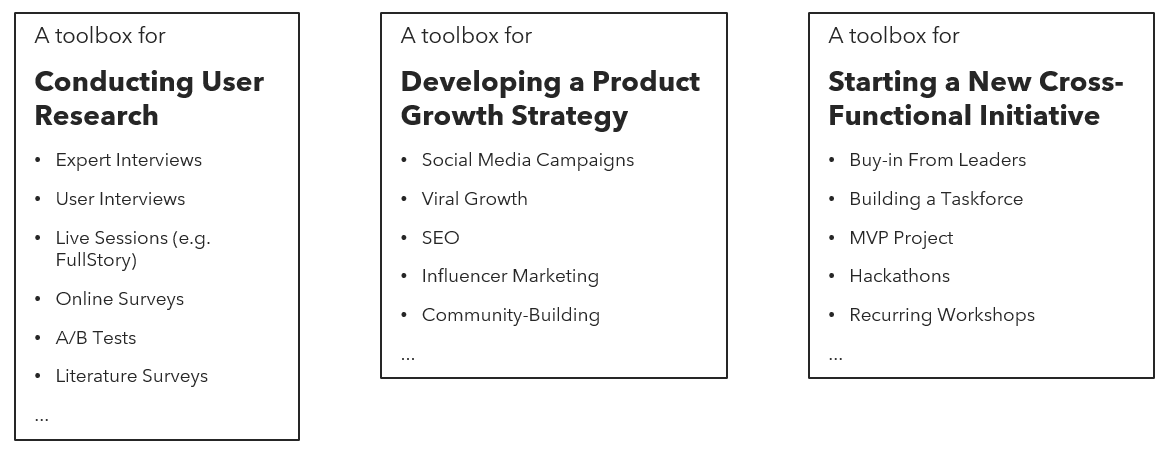As Product Managers we often need to take on tasks that we haven’t done before (this is probably true for many who aren’t PMs as well). When learning something new in such scenarios, when unsure of how to get started, I have usually found it very helpful to build a toolbox for this new task/skill.
To make this methodology easy to repeat, I have also created a framework called GTEO (Goal-Toolbox-Experiment-Optimize) to help put this idea into practice.
What’s a toolbox
I define toolbox simply as: A toolbox is a list of tools that could help with the task on hand. Here are a few examples:

Building this list is more of an art than a science, especially when we are unfamiliar with this subject area. Many sources can help: we could do secondary researches and look for trustworthy literature, ask for advice from experts, take courses on the subject, etc.
This exercise is also more than just jotting down names of tools. We can think about this toolbox-building experience as a device to force us to learn the ropes for the most common ways to achieve our goal. After all, we cannot decide the content of our toolbox without learning the basics of the tools.
How to use the toolbox (The GTEO Framework)
As mentioned above, I created what I call the GTEO framework to help make this a repeatable methodology. It simply breaks down like this:
- Goal: Identify what we are trying to achieve
- Toolbox: Build a toolbox containing tools that could help with the goal
- Experiment: Pick a small number of tools that seem most promising, try them out on a small scale, and observe each tool’s effectiveness
- Optimize: Commit to using the most effective tool(s), iterate to optimize their performance, and focus on applying them to achieve our goal
Let me illustrate how this framework works with a non-PM example.
- Say I need to fix a fence (excuse any inaccuracy in my woodworking metaphor!), and to do that I need to join pieces of wood at several places (Goal).
- I may look up DIY videos on YouTube and list out the tools that I may want to use vs. the ones I may not (Toolbox).
- I might then say, “Looks like screws or wood glues make the most sense!”, and start trying them out on some spare wood pieces laying around (Experiment).
- After realizing using screws is faster and more reliable, I decide to only use this tool to complete all the wood-joining tasks, and focus on practicing this one skill for the remainder of the task (Optimize).
Similarly, now a Product Management example using the GTEO framework.
- If I’m about to conduct some user research for the first time for StackAdapt, I would start by defining my Goal: perhaps I want to know if our platform has any UX gaps that would increase client productivity when fixed.
- Then I’d take some user research training and create my Toolbox, which might look like the leftmost one in the image above.
- From it, my educated guess would be to pick the following tools to Experiment with:
- Expert Interviews, because our friendly Revenue team is very knowledgeable about client experiences
- User Interviews, because I can easily invite clients from various backgrounds to chat with me
- Live Sessions, because I have access to rich live session data via FullStory
- Finally, I decided that User Interview is the best tool to Optimize on, because after just two interviews, I uncovered so much unbiased opinions on our UX, that are not the usual subject of conversations Revenue has with clients, and that are hard to capture in FullStory sessions. I now go all-in on User Interviews and will be setting up another 8-10 interviews to gather qualitative data.
What makes the GTEO framework useful
I have found this methodology helpful throughout my career for three reasons.
First, every time I enter a new area, the GTEO framework provides a repeatable roadmap for navigating through ambiguity. Even though it won’t make me an SME immediately, the journey of building a toolbox can always function as a self-inflicted crash course on the subject matter.
Second, as a learner, the Experiment and Optimize steps help me gain confidence. When I put the tools I just learned about into practice, even on very small scale, I start seeing some results, and results are the best catalyst in confidence building.
Finally, the GTEO framework has a lasting impact even after I grow past the newbie phase, because it helps me learn to master helpful tools and build long-term skills. The toolboxes I have built earlier in my career are still very helpful to me today, as frequently used references that I use to kick off projects quickly.
(Copyright notice generated by Bing: This Photo by Unknown author is licensed under CC BY-SA.)
